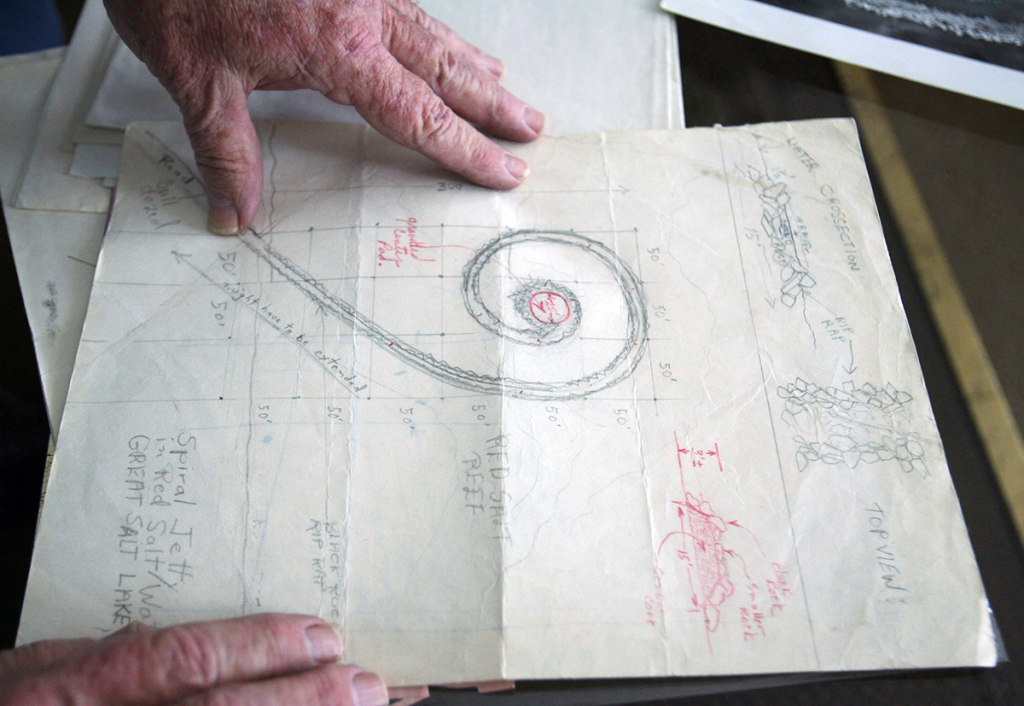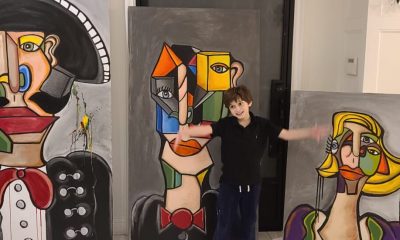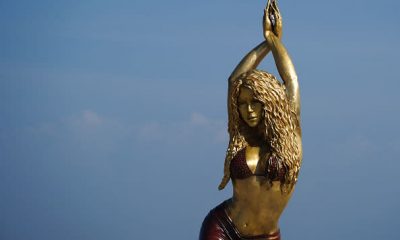ART WORLD NEWS
New Interview Footage of Robert Smithson His Late Work – ARTnews.com
“There’s this kind of trying to make things out of senseless situations.” Isn’t that what we’re all trying to do right now, to grasp our bewildering political/social/public health circumstances, and then maybe make things—art, texts, snapshots, journal jottings—that capture our moment? Robert Smithson’s statement leaps the decades to speak to our own era about the function of art and its “dialectical”—one of his favorite words—relation with society. Serendipitously, the transcript of a 1972 interview with him just became publicly available.
Smithson’s talk was for the oral history program of the Archives of American Art. The transcript of the first tape has been available for decades on the organization’s website. Before that, it could be found in Smithson’s collected writings, edited by his widow, Nancy Holt, in 1979 and reissued by Jack Flam in 1996. The new material is from a second tape, for years mislaid.
Related Articles
Smithson gained recognition, starting around 1966, for sculpture both highly conceptual and inventively materialized, and for idiosyncratic essays mixing commentary on new forms, scientific and geological data, and fantasy narratives. These esoterica were spiced with sardonic observations and quotations from literature and science fiction. The artist was increasingly sought for interviews. (I discovered a 1968 Smithson interview by curator and editor Willoughby Sharp, and it debuted under the title “Degrees of Disorder” in the December 1998 issue of Art in America.) But the Archives’ oral history project is distinctive in three ways. First, its coverage ranges from Smithson’s birth to just a year before he was eulogized in a High Requiem Mass sung in Latin, following his death on July 20, 1973, in the crash of a small plane while making the Amarillo Ramp.
The new material highlights the last phase of the artist’s professional life, from 1969 to 1972. It includes loose talk on the pragmatics of building his two big projects, Spiral Jetty in Utah and Broken Circle/Spiral Hill in the Netherlands, enlivened by frequent exclamation such as: “You can’t believe how red the water is. . . . Rose red. . . . Chianti.” His excitement indicates the importance to him of that hue, but we must go to his essay on the Spiral Jetty to learn what it called up: “My eyes became combustion chambers churning orbs of blood.” Interviewer Paul Cummings, a specialist in twentieth-century painting and director of the AAA oral history program, had the prescience to select Smithson, at 34, for the famed repository. But he seemed not to fully comprehend either what his subject was doing or, as Cummings put it, “all the different bits of nomenclature that the critics are developing out of somewhere”—such as “process art, earthworks.” The latter term was originated by Smithson five years earlier in his “Air Terminal Site” article in Artforum (June 1967). Ignoring Cummings’s dismissive remark, the artist adroitly turned to describing a thematic continuity and his artistic goal:
Portrait of Robert Smithson, 1972.
Courtesy Holt/Smithson Foundation.
“A world view in terms of being entropic . . . runs right through. . . . There is this preoccupation, in other words, that you develop these mental structures, and then I was trying . . . to develop a reflection in terms of the physical world, so that these two things could coincide. The mental and the material, in a sense inform each other.”
So the second value of the Archives’ tape is that it offers not just procedural information on Smithson’s work but a self-analysis of his process. The above statement is a rare disclosure of the artist’s intention; it indicates that his work is not just cerebral, however much it has been lauded for that quality. Rather, it expresses interior subjective states. The form and material manifest latent psychological content. That interaction, in turn, is strongly connected to Smithson’s fascination with entropy, the tendency of discrete systems to decay toward a simpler state, as when a pendulum—or a heartbeat—slows and stops.
The third revelatory value of this recording is Smithson’s admission, “Well, I haven’t really worked on a major piece since Broken Circle. That’s a little more than a year ago now, and I’ve just been trying to, in a sense, find a way out of the current art world context into another context.” These comments make evident, like no others anywhere, Smithson’s struggle to reposition his work after his art dealer and patron, Virginia Dwan, closed her gallery the previous year. John Weber, her former director, who then began representing Smithson in his own gallery, did not have the resources to fund earthworks.
Smithson’s experience in the Netherlands—building environmental sculptures in a commercial gravel quarry, a project sponsored by Arnhem’s annual Sonsbeek sculpture exhibition—had opened a new direction. The experience gratified him:
“It wasn’t confined by a park or a museum, which I thought was a very good thing. And I feel that that’s one of the major problems right now, to overcome that kind of confined shell. . . . I think the metaphysics of the “thing in itself” have run their course, and . . . it’s no longer convincing to me as legitimate. . . . I’ve had to work my way out of that notion of isolation to a more relational view.”
But his forward movement seems to have stalled. Smithson’s posthumous exhibition catalogues identify no sculpture made in 1972; that summer his contribution to Documenta was solely an 850-word diatribe titled “Cultural Confinement.” a declaration of artistic independence that became his most quoted essay.
Robert Smithson: Ring of Sulphur and Asphalt, 1972, 12 5/8 by 16 2/4 inches.
© Holt/Smithson Foundation / VAGA at Artists Rights Society (ARS), NY.
Smithson’s new “relational view” looked in two directions. One was to the audience:
“I’m really not interested in alienating the ordinary person. I’m interested in having the art affect as many people as possible, and yet keep it as something . . . that really has a strong impact. And I would like as many people to be involved with it as possible, from different walks of life. I enjoy talking to these people, because they seem to . . . [be] involved in concrete problems.”
In contrast to the Artforum clique that he successfully joined in the mid-1960s with essays about arcana like “dedifferentiation,” he seems to have become a populist, or an advocate of—as we say today—inclusivity.
But first Smithson had to take another direction, trying to convince corporate officers to let him transform disused mines and waste tailing ponds into sculptural environments, attractive as public amenities. He justified his sparse productivity of essays after the late ’60s by telling Cummings:
“I feel that the problem right now is very different. And I think, well, [I’ve] been mainly trying to coordinate projects, and writing letters, which have to . . . make sense to people that don’t know anything about art . . . [a] very brass tacks, instructional kind of epistles.”
Epistles? In using that term for apostolic letters in the New Testament, Smithson both likened himself to a proselytizer of the value of art to nonbelievers and let slip his affiliation with Catholicism, which after his early ’60s paintings of Christ’s Passion, he concealed. He and Holt sent out thirty-eight letters that presented written and drawn project proposals to art heathens in executive suites at companies such as at Kennecott Copper, Union Carbide, and United Nuclear. None were converted.
So no wonder that advocating the importance of art became urgent for Smithson. The corporate resistance seemed to incite blunt assertions. When his art practice and livelihood were at stake, he said things that need to be regularly reiterated and affirmed, especially today:
“Art is a necessity, rather than a luxury. . . . I want to get away from luxury, I want to get into necessity . . . I feel [art] is very necessary.”











